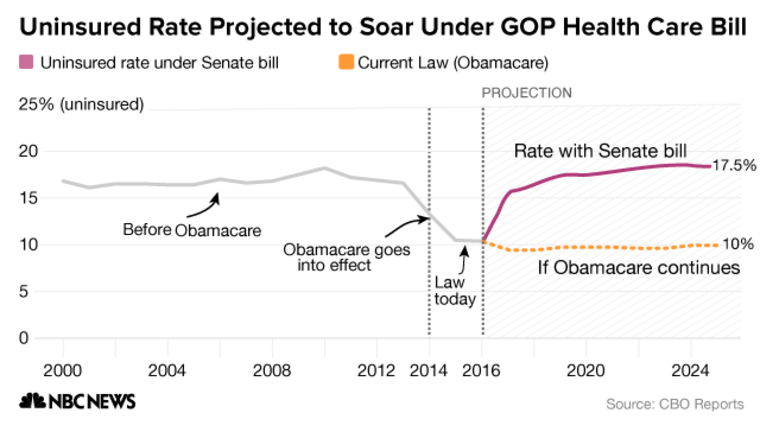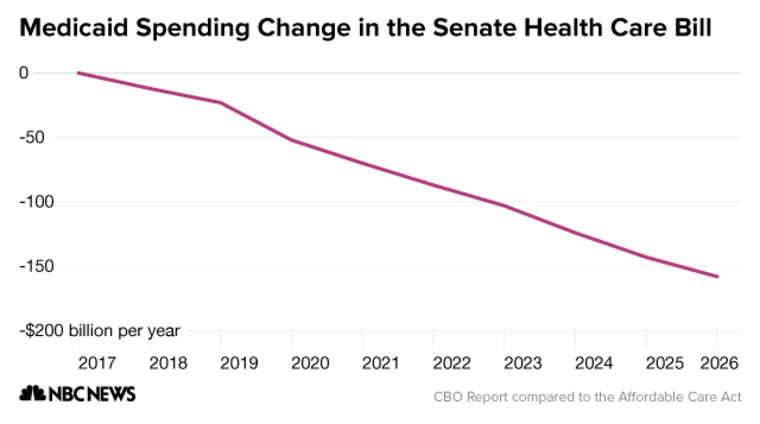President Donald Trump said his health care would be better and cheaper than Obamacare.
But that's not how things are turning out.
Based on the president's previous statements, people would enjoy lower premiums and deductibles. A replacement would cover everybody, including those with pre-existing conditions. There would be no cuts to Medicaid.
Now, as Senate Republicans finalize their legislation while Trump advocates for its speedy passage, the question is: Does the bill keep the president’s promises?
Here's how Trump's vows on the campaign trail and after taking office stack up against the findings from the non-partisan Congressional Budget Office report released Monday.
1. “We’re going to have insurance for everybody … There was a philosophy in some circles that if you can’t pay for it, you don’t get it. That’s not going to happen with us.”
— Trump to the Washington Post in January 2017
What the CBO Score Says
By 2026, 22 million fewer Americans would be covered than under the current law. That’s only a slight improvement from the 23 million Americans estimated to lose coverage under the House GOP bill, and a far cry from “insurance for everybody.”

2. “I’m not going to cut Social Security like every other Republican and I’m not going to cut Medicare or Medicaid.”
— Trump to the Daily Signal in May 2015
What the CBO Score Says
The Senate bill slashes Medicaid, leaving 15 million fewer people covered by 2026. Overall, $772 billion less will be spent on the program, but the cuts could go deeper as the Senate bill sets Medicaid on pace to grow more slowly than the House health care bill beginning in 2025. (The CBO score only looks at a ten-year window.)
While the House version of the bill also cut Medicaid, the Senate's cuts are deeper in the long term but slightly less severe in the short term.

3. “Will have much lower premiums & deductibles while at the same time taking care of pre-existing conditions!”
“Our healthcare plan will lower premiums & deductibles — and be great healthcare!”
What the CBO Score Says
Without factoring in subsidies to buy insurance, average premiums will rise ahead of 2020, and fall thereafter by about 30 percent, the CBO report notes. This is largely because plans under the bill would offer less comprehensive coverage and pay a smaller percentage of health care costs than the plans available under the existing bill.
Overall, out-of-pocket costs would rise for most people, according to the report. Deductibles will be higher. Roughly half the population lives in states that will obtain waivers in order to define which benefits must be covered by insurers, and they would see a “substantial increase” in their out-of-pocket costs. Things like maternity care and mental health could become far more expensive in states that use waivers to cut them from the list of benefits that must be covered.

The CBO also notes that states who seek those waivers could see annual and lifetime limits — which were banned under Obamacare — imposed.
Insurers will be barred from refusing coverage to or charging individuals with pre-existing conditions more than other individuals, however, though state waivers will allow insurers to stop covering some of the benefits Obamacare deemed "essential."
— Trump tweet in February 2016
What the CBO Score Says
The Senate’s bill repeals the largest parts of the Affordable Care Act — axing the individual and employer mandates, the Medicaid expansion, many of the taxes on the wealthy and insurers, while rolling back most of the subsidies.
When it comes to saving individuals money on health care, the CBO evaluates that in many cases, health care will actually be more expensive. Older Americans — who can now be charged more based on age — and certain low income Americans will particularly see hiked costs. But the CBO also estimated that the bill would save taxpayers $321 billion by 2026.
